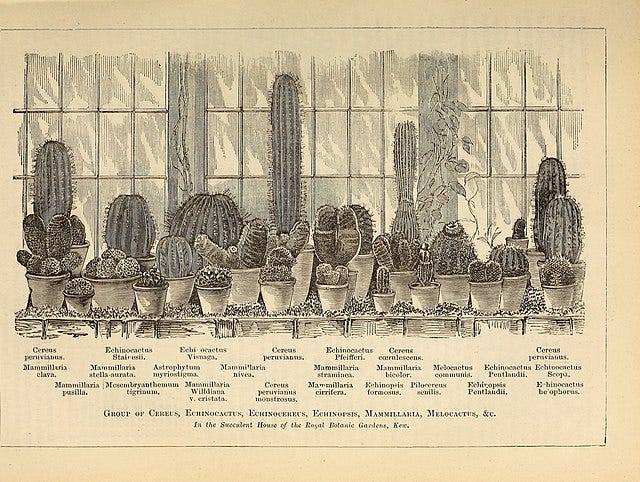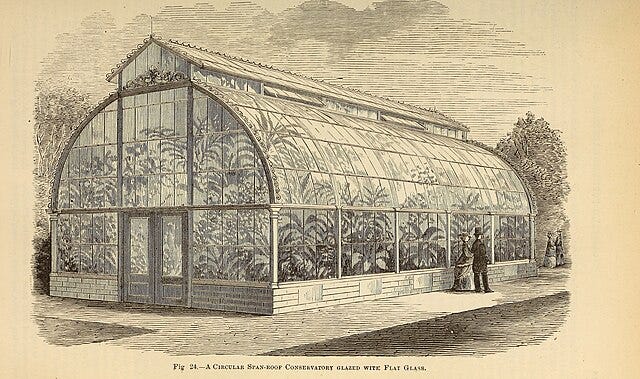Gardening Trends Through the Lens of Behavioural Science
A few fascinating things from the world of behavioural science to consider the next time you want to join in or even start your own hort trends
One of the most exciting aspects of modern horticulture, is the constant surge of new ideas. There are always interesting things to try, observe and put into action. But, this also presents a challenge, how do we pass on these ideas to consumers and clients?
Now, you may think, I’ll start a project, invent a product or maybe write a book and that will get my ideas out into the mainstream. Which of course is brilliant, but the next issue is, how do you get people to notice what you’ve produced?
As you may imagine, human psychology has a large part to play. And, although I am certainly no behavioural scientist, I do enjoy learning more about why we do the things that we do. So, let’s put on our arm chair scientist hats, and delve into some of the concepts that I’ve come across. They may just help you to understand your own part in gardening trends and also how you can help to create meaningful new ones.
What’s in a Name?
we love a memorable name, tag line or mantra, it helps us to categorize the complex world around us. Grouping information allows humans to react quickly to new experiences and situations. As new concepts enter the horticultural sphere, we want to name and define them and decide if our own beliefs aline with them. The simpler the concept, the easier it is for us to agree or disagree. So, be sure to choose something catchy that speaks to your ethos.
Consider, forestry professor Cecil Konijnendijk, who spent years trying to convince municipalities of the benefits of enlarging city tree canopy coverage. It was only in 2021, when he gave up promoting more complicated guidelines and instead published his, 3-30-300 rule, that they really began to listen. “The rule calls for every resident to be able to see at least three decent-sized trees from their home and live in a neighbourhood with at least 30 per cent tree canopy cover, with the nearest public green space no further than 300 metres from their door.” In the end, even though the rule isn’t perfect, it is something simple that city planners and citizens alike can easily grasp and follow. And today, 3-30-300 can bee seen in use across the globe.
Branding
This speaks to our social nature, we seek out tribes and communities and we tend to see brands as an extension of that. We regard them as ‘family’ and will show loyalty to the brands that we love over a lifetime. So build one that’s clear and strong and try to stay true to it’s ethos because love can turn to backlash if people feel deceived.

Eco Marketing - Buyer Beware
It is handy to remember that some trends are linked to sales. Horticulture is a business (projected to reach 40.24 Billion USD by 2026), and trends can be manipulated to increase consumerism. Being aware of what you’re being sold and how it may differ from your expectations can be an important factor. Especially if you’re the one putting it out there, expect those seeking to make a profit to quickly monetize any trend that you may start.
A few things to look out for…
virtue signalling - the public expression of opinions or sentiments intended to demonstrate one's good character or social conscience or the moral correctness of one's position on a particular issue. (Oxford)
green washing - when a company or organization spends more time and money on marketing themselves as being sustainable than on actually minimizing their environmental impact. (earth.org)
Trends are great, who doesn’t enjoy a fun one? But, we do have to look beyond the surface level. If you are buying a product, you want to make sure that it meets your expectations (whatever they may be).
Be certain that you’ve throughly researched what you’re offering. If you’re buying or selling ‘native’ plants for instance, understand that terms like ‘native’ are relative. Consider, are the plants actually indigenous to your local ecosystem? do they fit the site conditions, and those expected in the future? How are they produced, and will they last? Be sure that all of your boxes are ticked before you promote a trend. Misunderstandings or misrepresentation can easily lead to negative pushback.
Human Behaviour & Trends
As much as we like to think that we are all individuals, we have evolved some common traits. Therefore, learning a few basics of behavioural science can help us to better understand the larger picture of trends and what part you may take in them.
intention vs action - There is a wide gap between wanting to do something and actually doing it. One study noted that 70% of respondents wanted to be eco-friendly, while only 25% actually purchased eco-friendly products.
self-efficacy - generally speaking, we want to know that what we do matters, that our actions have a meaningful impact.
not alone - We don’t want to be the only one’s contributing. We want to see our neighbours out there cycling, installing solar panels and consuming less - in fact we’re more likely to do things if those around us are too. So…
make it visible - We want others to see that we’re making positive choices and acknowledge our effort. As an example, when people are required dispose of their garbage in clear bags, they recycle more. So, consider including some form of reward that they can share publicly - special signage, merch (pins, t-shirts, stickers and bags), hashtags and exclusive insta-traps and more.
desire to belong - Humans are social animals with an innate desire to share values within their society. Generally, we want to do good and have others perceive us as being a force for good. So remember that even though you will face detractors and some negativity, try to focus on those that are seeing the positive aspects in the ideas that you’re introducing.
mitigate negative effects - Sometimes products and ideas come with attitudes attached them by society. For instance, some people may equate ecology with austerity, so consider using humour or a sense of whimsy to overcome that.
prompts and positive feedback - Another great way to encourage people is to offer a positive reminder. If you include a plant tag that notes, “by adding this plant to your garden, you’ve just helped to feed your neighbourhood Swallowtails”, you’ll give clients an instant boost.
build positive habits - Finding a way to make the action that you’re promoting a new default will help it gain acceptance. If paper bags are free and plastic cost 5 cents, the majority are bound to choose paper without added prompting.
competition between groups - We’re often spurred into action when our tribe’s reputation is on the line, so include a competitive aspect. Students vs teachers for instance, city vs city or even one trade vs another. Some fun healthy rivalry might just help get people talking about your cause.
scarcity principle - We’re all familiar with this one, but it bears repeating. Rare items are perceived as being more valuable. This can be equal parts positive and negative depending on what’s being promoted, but it’s good to keep in mind.
positive spillover - Making one good choice often leads to more, median change over time is more effective than a single large change. Therefore, presenting new ideas and actions as available in smaller steps is more attainable to a greater majority of people.
emotional appeals - It goes without saying too much, that touching on a positive emotion is more effective than a negative one (ie “you did good today” vs “look at all the bad going on in the world, why aren’t you doing more”). And always avoid explicit guilt, sadness or fear, eliciting these are bound to encourage backlash.
practical appeals - The opposite side of the coin to an emotional appeal is one based on dollars and cents. Sometimes simply laying out the value of what you’re promoting in practical terms, especially over time can say a great deal. If I were to say for instance, “that a city spends $90,000/year watering and maintaining their conventional garden beds vs a drought-tolerant low maintenance planting in the same space which will cost $10,000/year (after the initial year)”, which would you choose?
loss aversion - We prefer to avoid loss rather than make gains. It seems crazy but it’s true, think about it. If I were to suggest removing all of the plants in your garden and replacing them with butterfly-friendly materials would you? And, what if I asked you to add some butterfly habitat to your existing green space?
local is more effective - Feeling connected to our local communities in natural, so if there’s a way that we can do something good while supporting it, we’re in. It helps to bring a concept home, literally. As an example, when New York City released a statement that, one days trash can fill the empire state building, it made locals take notice.
experience over ownership - Personal relationships, connection and memories often hold more value for us than simply owning something. For instance if you’re asking for volunteers, offer them something that they will value more than a pay check. The High Line park hosts group work parties every spring for their annual, Spring Cut, garden maintenance. Where volunteers get to join a team of like-minded individuals (that they may not otherwise meet), celebrating the arrival of spring, while beautifying their neighbourhood and revelling in the therapeutic aspects of horticulture. Sound good, right?
Where Does This Leave Us?
Wherever you fall in regards to gardening trends, being aware of how information is effectively disseminated can be hugely helpful. Whether you’re attempting to start a new trend or are considering joining in a current one, a little research and knowledge are key. We all want to feel like what we do in our gardens matters.
Please join us in the comments section and let us know how you feel about industry trends, are there any that you’re behind or any that you’re dying to see others embrace? And, would you consider using any of these behavioural science tips to make an impact?
Sara-Jane & Alica at Virens Studio
Virens is a Vancouver, Canada based studio, specializing in ecological landscape and planting design. As well as, urban greening and naturalistic garden consultation, plus freelance garden writing. Find us today on Substack and Instagram, follow and say hello.








I've just cleared out a garden shed that came with the 25 year old house we recently bought. It was astonishing to see all the half-used bottles of insecticides and herbicides lurking in there. It really wasn't that long ago that killing ALL the bugs and weeds was a "thing" in gardening. We really have come a long way. (I'm also very grateful my local recycling depot could deal with it all responsibly, I had zero idea what to do with it all).
Like the Naturalistic Plant Design movement. After many years start now to become public recognised.